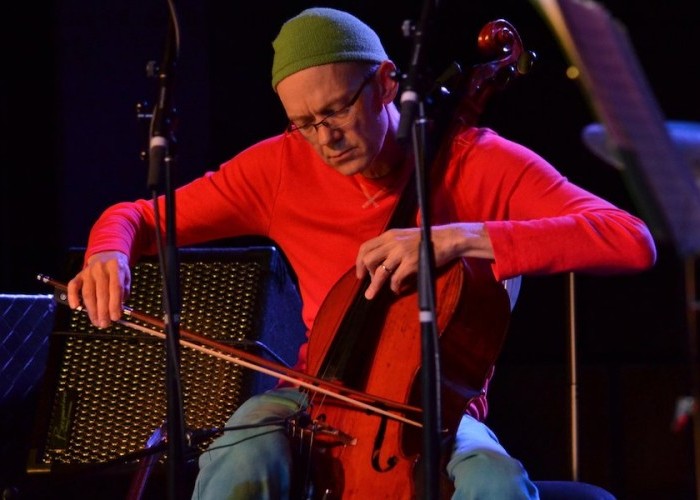Oct 28, 2025 10:47 AM
In Memoriam: Jack DeJohnette, 1942–2025
Jack DeJohnette, a bold and resourceful drummer and NEA Jazz Master who forged a unique vocabulary on the kit over his…

Cellist Hank Roberts has returned to New York to embark on projects with old friends.
(Photo: Lynda Wyatt)At the cusp of the 1970s, when Hank Roberts was a high school student in Terre Haute, Indiana, he aspired to be a jazz trombonist, a classical cellist and a blues guitarist. Ultimately, Roberts honed in on the cello, and during the ’80s and ’90s he emerged as an inspirational practitioner of that instrument via recordings and tours with Bill Frisell, Tim Berne, the string trio Arcado with bassist Mark Dresser and violinist Mark Feldman, and other members of the emergent so-called “downtown jazz” scene in New York. There were also several well-wrought leader albums that showcased his own poetic Americana-inflected jazz argot, harmonic acumen and rhythmic flair. In each context, Roberts projected a mighty arsenal of extended techniques, bowed and plucked, shape-shifting the cello into a veritable orchestra.
Roberts coalesces all the aforementioned styles and attributes on his most recent release, Science Of Love (Sunnyside), consisting primarily of a kaleidoscopic, 44-minute, 13-part suite titled “G.” Recorded in June 2017, it’s a bespoke, unified work tailored to the tonal personalities of a virtuoso sextet — trombonist Brian Drye, violinist Dana Lyn, woodwindist Mike McGinness, pianist Jacob Sacks and drummer Vinnie Sperrazza — whom Roberts, a father of four, met after responding to the 21st birthday of his youngest by moving to Brooklyn from Ithaca, New York. In spring 2018, Sacks and Sperrazza joined Roberts on Congeries Of Ethereal Phenomena (Newvelle Records), an interactive encounter on which Roberts, functioning as the sole “horn,” efflorescently addresses six venturesome originals, an abstraction of Thelonious Monk’s “Evidence” and a swinging version of “Indiana” extrapolated onto Charlie Parker’s contrafact “Donna Lee.”
He returned to Ithaca in 2019, where in June he spoke of his 2015 imperatives. “Although I was playing and recording, a limited group of people were hearing me,” Roberts said. “I wanted my work to be recognized and to try to make a living with it — and a sense of community by playing and communing with people on that level.”
Then 61, Roberts embarked on new projects with old friends like Berne, Michael Formanek and Marty Ehrlich, and with his next-generation Brooklyn collaborators, who deeply respected Roberts’ distinguished corpus. Soon thereafter, Drye invited Roberts — who was writing music for woodwind player Anna Webber and drummer Tomas Fujiwara — to play at Ibeam, the eminent creative music venue that he oversees in the Gowanus neighborhood of Brooklyn.
In short order, Roberts convened his sextet and began to conceive the music. “I thought of setting up a framework that would inspire and challenge each person, and bring them to a place of revelation where they can discover something and bring that excitement of discovery and self-discovery to the table,” he said.
“We would try things, and Hank made adjustments and new sections,” said Sacks, who analogized interacting with Roberts to “playing with a great singer.” “It definitely wasn’t, ‘Here’s my piece; now we shall render it.’ It was definitely much more: ‘Who are these people? What are your sounds?’”
When we spoke, Roberts was anticipating a September tour with Frisell behind Harmony (Blue Note), their 10th record together, on which he sings (and plays cello) with vocalist Petra Haden and bassist Luke Bergman. Then he hopes to set up work in New York, where he intends to resume activity with the sextet and to follow up with Drye on the trombonist’s Trio Love Call (Open Stream) album with drummer Ches Smith. Other recent collaborations include Vancouver guitarist-oudist Gordon Grdina’s The Marrow, a jazz-Arabic-Persian oriented project that includes Roberts on Ejdeha and Safar-e-Daroon (Songlines); with Pipe Dream, an Italian quintet documented on an eponymously titled 2017 album (C.A.M. Jazz); and, separately, in duo with Pipe Dream’s trombonist, Filippo Vignato, documented on 2019’s Ghost Dance (C.A.M. Jazz).
“Not being with the people I connect with through music affected me,” Roberts said of his COVID experience, before breaking down the Science Of Love title. “It showed me how special it is to work together and communicate as we do. I’m interested in astrophysics, and enjoy looking at universal laws and principles that create life. That equates to love, too, and it’s one of the things that draws us to music.” DB

Jack DeJohnette boasted a musical resume that was as long as it was fearsome.
Oct 28, 2025 10:47 AM
Jack DeJohnette, a bold and resourceful drummer and NEA Jazz Master who forged a unique vocabulary on the kit over his…

Always a sharp dresser, Farnsworth wears a pocket square given to him by trumpeter Art Farmer. “You need to look good if you want to hang around me,” Farmer told him.
Sep 23, 2025 11:12 AM
When he was 12 years old, the hard-swinging veteran drummer Joe Farnsworth had a fateful encounter with his idol Max…

D’Angelo achieved commercial and critical success experimenting with a fusion of jazz, funk, soul, R&B and hip-hop.
Oct 14, 2025 1:47 PM
D’Angelo, a Grammy-winning R&B and neo-soul singer, guitarist and pianist who exerted a profound influence on 21st…

Kandace Springs channeled Shirley Horn’s deliberate phrasing and sublime self-accompaniment during her set at this year’s Pittsburgh International Jazz Festival.
Sep 30, 2025 12:28 PM
Janis Burley, the Pittsburgh International Jazz Festival’s founder and artistic director, did not, as might be…

Jim McNeely’s singular body of work had a profound and lasting influence on many of today’s top jazz composers in the U.S. and in Europe.
Oct 7, 2025 3:40 PM
Pianist Jim McNeely, one of the most distinguished large ensemble jazz composers of his generation, died Sept. 26 at…